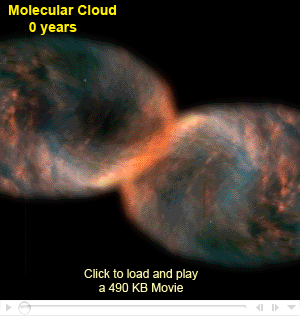B Class Stars
(Blue Giants)

- very large stars.
- very hot stars. Much of their radiation is emitted at the blue end of the spectrum and beyond.
- factories for producing heavy elements. All the elements up to iron are synthesised in their cores.
Life Phases
- Formation phase. Gravitational collapse of a molecular cloud. Duration: a few hundred thousand years.
- Main sequence hydrogen fusion phase. Hydrogen is fused rapidly and that fuel source is exhausted in a few tens of millions of years.
- Red Supergiant phase where they fuse helium and heavier elements. Duration: a few hundred thousand years.
- Supernova explosion phase. Only the most massive B class stars have sufficiently massive cores to undergo this phase. When fusion ceases in them, the core collapses. Elements heavier than iron are synthesised during the collapse. Matter is blasted back into space by the explosion.
- Collapsed core phase. The cores of less massive B class stars become white dwarfs. During the earliest stages of a white dwarf's formation, the outer layers of their red giant phase atmospheres are expelled in surrounding space as planetary nebulae. White dwarfs are intensely hot when they first form, but they have no more fuel to burn. For the rest of time they simply cool down by radiating heat. (Perhaps then they could be called black dwarfs, but there has not been enough time for any such objects to form in this universe.)
Abundance
- B class stars are uncommon. They form together with O stars in the densest dust clouds and have relatively short lives.